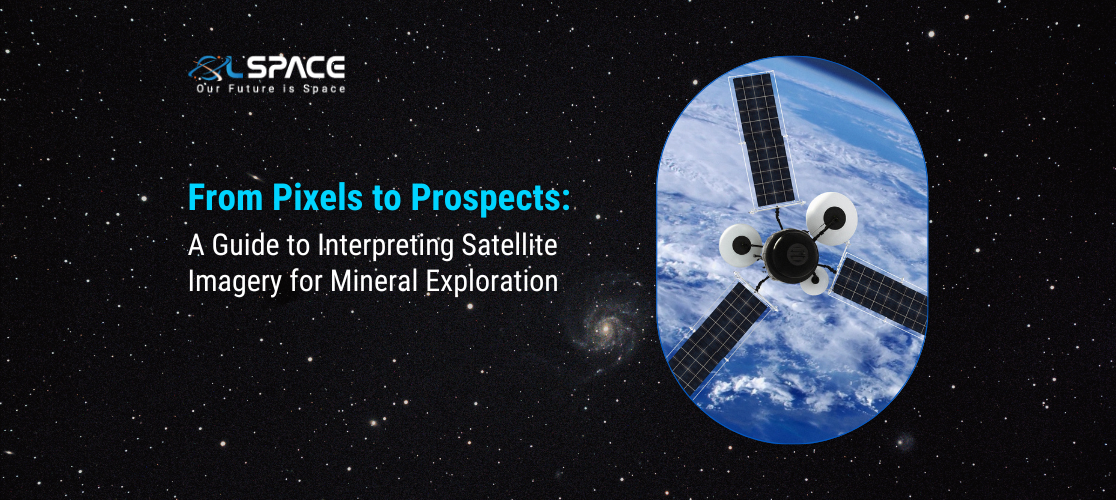24 November 2023
From Pixels to Prospects: A Guide to Interpreting Satellite Imagery for Mineral Exploration

Satellite imagery has emerged as a powerful tool in mineral exploration, offering a unique perspective that aids geologists in identifying potential mineral deposits across vast and often inaccessible terrains. The interpretation of satellite imagery involves transforming pixels into actionable insights, guiding exploration efforts and contributing to the discovery of valuable mineral resources. In this guide, we will explore the key steps and considerations in interpreting satellite imagery for mineral exploration.
1. Acquiring High-Quality Satellite Imagery:
The first step in the interpretation process is to acquire high-quality satellite imagery. Choose imagery with suitable spatial and spectral resolution based on the specific requirements of the mineral exploration project. Consider factors such as cloud cover, temporal resolution, and the availability of multi-spectral or hyperspectral bands.
2. Understanding Spectral Signatures:
Different minerals exhibit distinct spectral signatures in satellite imagery. Familiarise yourself with the reflectance patterns of common minerals in various spectral bands. For example, iron-bearing minerals may have unique absorption features in the near-infrared spectrum. Understanding these spectral signatures is essential for identifying potential mineral deposits.
3. Image Enhancement Techniques:
Apply image enhancement techniques to improve the visibility of geological features in satellite imagery. Techniques such as contrast stretching, histogram equalisation, and pan-sharpening can enhance the visual clarity of the images, making it easier to identify subtle geological variations.
4. Geological Mapping and Land Cover Analysis:
Conduct a geological mapping exercise by identifying and mapping geological features visible in the imagery. Differentiate between rock types, structural features, and alteration zones. Additionally, perform land cover analysis to distinguish vegetation, water bodies, and barren areas, as these factors can influence mineralisation.
5. Multispectral and Hyperspectral Analysis:
Leverage the multispectral or hyperspectral capabilities of satellite imagery to analyze specific wavelength bands associated with mineral identification. Perform band ratio analysis or use spectral indices to highlight regions indicative of potential mineralisation. For instance, the Normalised Difference Vegetation Index (NDVI) can help identify areas with sparse vegetation, which may be associated with mineral deposits.
6. Geological Structure Identification:
Satellite imagery allows for the identification of geological structures such as faults, folds, and shear zones. Analyse the topography and structural patterns visible in the imagery to gain insights into the geological history of the area. Structural features can influence the deposition and concentration of minerals.
7. Integration with Geospatial Data:
Integrate satellite imagery with other geospatial data, including geological maps, topographic maps, and geophysical data. Overlaying these datasets can provide a more comprehensive understanding of the geological context and aid in the interpretation of satellite imagery.
8. Change Detection Analysis:
Conduct change detection analysis by comparing historical satellite imagery with recent acquisitions. Identify changes in land cover, vegetation health, or surface mineralogy, as these changes may indicate evolving geological conditions or new mineralisation.
9. Collaborative Interpretation:
Foster collaboration between remote sensing specialists, geologists, and other experts involved in the mineral exploration process. Combining domain expertise with remote sensing capabilities enhances the accuracy of interpretation and facilitates a more holistic understanding of the geological landscape.
10. Field Validation:
Validate the interpreted results through field visits and ground truthing. Fieldwork is essential to verify the presence of mineral deposits, confirm geological interpretations, and assess the accuracy of satellite imagery-based analyses.
Conclusion: Unveiling Prospects from Pixels
Interpreting satellite imagery for mineral exploration is a multidimensional process that involves combining technical expertise, geological knowledge, and advanced remote sensing techniques. By transforming pixels into prospects, geologists can identify potential mineral deposits, guide exploration strategies, and contribute to the sustainable development of mineral resources. As technology continues to advance, the integration of satellite imagery with innovative analysis methods will further refine the capabilities of mineral exploration in unlocking the Earth’s hidden treasures.
Join our community and never miss an update! Subscribe to our newsletter and blog to stay up-to-date on the latest trends, tips, and insights in your area of interest. Don’t miss out on exclusive content, promotions, and special offers. Sign up now and be a part of our growing community!
